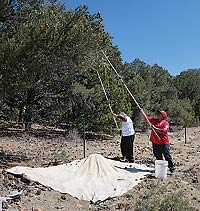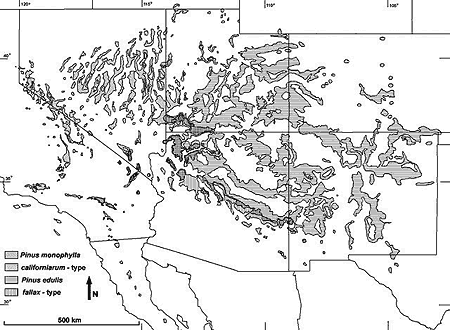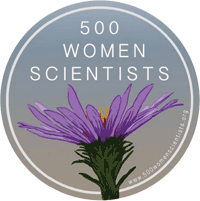Do you like pine nuts? Most store-bought pine nuts (sometimes called piñons or pignoli) come from Europe or China, but we are lucky to have a local source from a tree common around Moab. Pinus edulis, or the two-leaf pinyon, grows throughout the mid-elevations in our area, with additional species of pinyon pines found throughout the Intermountain West. And piñon season is upon us! Pine cones usually turn brown and open to expose the ripe nuts in the late summer and fall. You may begin to notice one common indication that pine nuts are ready. Pinyon jays, a bird that specializes in eating pine nuts, congregate in large flocks during this season, raucously descending on pinyon trees to forage. For thousands of years, people have also depended on this tree.
 |
Shoshone women harvest pine nuts using long poles with a small cross-bar,
a traditional-style tool. PC Kate Magargal, 2018. |
Archaeological sites throughout the Colorado Plateau and Great Basin contain evidence that people harvested and consumed pine nuts. Shell and pine cone fragments are typical materials that indicate consumption of the nuts. Pine nut fragments located in human coprolites (ancient feces) further note the fact that people ate this local delicacy. Back when harvesting food from the surrounding environment was the only option, pine nuts were among the most calorie-rich plant foods available to prehistoric people. The abundance, portability, and durability of pine nuts provided sustenance through the lean times of winter and early spring. This legacy connection between people and pinyon trees maintains. Indigenous people across the West continue the tradition of harvesting pine nuts for use in stews, cakes, and snacks.
Although widespread throughout the Intermountain West, pinyon trees occupy a relatively specific and increasingly fragile ecological niche. The current extent of pinyon pines reflects their reliance on the monsoon rains. Pinyon pine trees slowly spread into this region about 8,000 years ago with the advent of the North American Monsoon. Dates from archaeological sites throughout Utah and Nevada indicate that people began harvesting pine nuts as soon as they were locally available. Today, as drought conditions become more frequent and more severe, pine nuts may start to become scarce. Drought conditions in 2002 and 2012 killed many pinyon pine trees across the region, and these types of events will likely continue to occur.
So what is a person who likes pine nuts to do? For now, the trees and the abundance they provide remain on the Colorado Plateau and Great Basin, and the changes happening to them offer essential insight. Our communities rely on a foundation of the environmental resources around us. In southeast Utah today, open space, oil and minerals, and water are some examples of the types of local resources that allow the people of Grand and San Juan counties to make a living. Although resources like piñons are a relatively tiny piece of our economy today, they are part of the complex web of human ecological connections that make this landscape habitable to people and many other species. Although a global economy currently allows us to import resources from far away, ultimately we rely on resources closer to home and our ability to make a living from them. Empowered by knowledge of how these connections develop and change through time, we are better equipped for the future
 |
| Habitat range of intermountain pinyon pine species. Figure from Cole, K. L., & Arundel, S. T. (2007). Modeling the climatic requirements for Southwestern plant species. In Proceedings of the Twenty-First Annual Pacific Climate Workshop. |
 Southeast Utah 500 Women Scientists
Mission and Values: Southeast Utah 500 Women Scientists
Mission and Values:
Our Mission:
• To share the importance of science.
• To support one another as a community of women scientists in Southeast Utah
• To be in service in the name of science to the communities of Southeast Utah.
Our Values
Being a supportive group for women scientists in Southeast Utah
Advocate for inclusivity in our group and in science at large
Increase scientific literacy for locals and tourists
Mentor and support students of science (especially girls) |
|